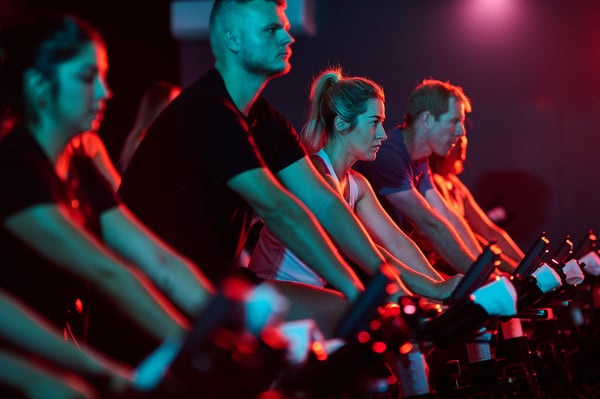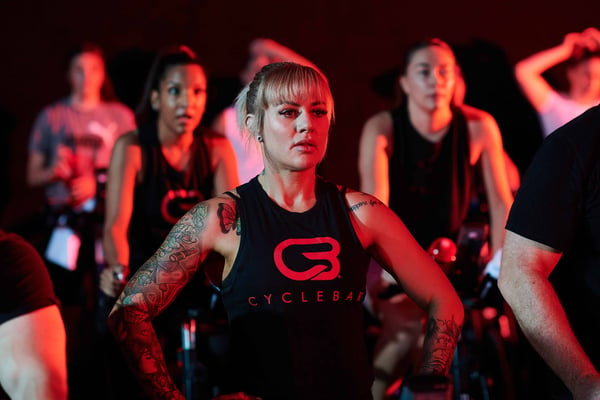While it’s important to push yourself during your session, the effort doesn't end when the session is over. What happens next is equally important: the recovery process!
Proper recovery is essential to ensure your muscles heal, grow stronger, and prepare for the next challenge. During an intense workout, the demands on your muscles are significant and will experience microscopic damage that can lead to muscle soreness and fatigue.
In this post, we will explore the best techniques to help your muscles recover after a spin class, so you can continue to perform at your best and enjoy your workouts to the fullest.
Delayed Onset Muscle Soreness: Understanding Muscle Soreness After Spin Class
If you’ve done any sort of workout, whether it is in the gym or at home, you’ve probably felt sore and tired the next day. This is normal, especially after an intense workout, like indoor cycling! Delayed onset muscle soreness (DOMS) is a common phenomenon that describes the strain and aches you feel after exercise.
Delayed Onset Muscle Soreness typically peaks within 24 to 72 hours after a workout and is characterised by stiffness, tenderness, and a reduced range of motion. While the exact cause is not known, many professionals believe that it is the result of muscle damage or microscopic tears as a result of eccentric movement (movement that lengthens the muscles) Muscle soreness can also be a result of inflammation as the muscles recover.
For many of us, feeling sore after a workout lets us know that we’ve worked hard. But, it is important to remember that DOMS is a sign of fatigue and can affect how you approach your next session. You may sit on the saddle differently, or pedal differently which can potentially lead to improper form and increase the risk of injury.
Read More: Spin Smart: Tips For Avoiding Common Cycling Injuries
.jpg?width=5313&height=3542&name=002_CYCLEBAR_210531_C5A0319%20(1).jpg)
Techniques To Relieve Muscle Soreness
Ultimately, DOMS is a sign of an intense workout, but that doesn’t mean it has to be so painful that it affects your routine or you avoid training as a result. Fortunately, there are several effective strategies you can implement to manage and reduce muscle soreness, allowing you to recover faster and get back to your workouts with less discomfort.
There are two common ways to recover after your spin session – Active and passive recovery. Active recovery means low-impact exercises and activities that promote blood flow without putting too much stress on the body. On the other hand, passive recovery refers to completely discontinuing exercise until you are fully recovered. The amount of passive recovery you need, however, will depend on your current fitness level and the intensity of the workouts.
1. Stretching
We are taught that pre-workout warmups are essential. They warm up the muscles and reduce the risk of injury. However, one thing that is often overlooked is the importance of post-workout stretching. They help improve flexibility, increase blood flow to the muscles and help alleviate muscle tension. There are two types of stretching that is beneficial in your post-spin routine: dynamic and static stretches.
Dynamic Stretches
Involves moving your muscles through a full range of motion, such as leg swings, arm circles, and walking lunges. These stretches prepare your muscles for activity while promoting blood circulation and flexibility.
Static Stretches
Static stretching involves holding a position that targets a specific muscle group for an extended period. Common static stretches include hamstring stretches, calf stretches and chest stretches. These stretches are particularly beneficial after a workout when your muscles are warm and more pliable.
2. Myofascial Release
Myofascial release, also known as soft tissue therapy, is an effective technique to reduce post-workout fatigue. It includes methods such as foam rolling and massage to target and release muscle tension.
Foam Rolling:
Foam rolling involves applying pressure to specific areas of your body to release tension, break up muscle adhesions, and improve blood flow. This technique is particularly beneficial for areas that are most commonly engaged during a cycle class – the glutes, calves and lower back.
When foam rolling, be sure to move slowly over each muscle group, pausing on any tender spots. Ensure that there is moderate pressure to avoid causing too much discomfort. The goal is to feel a gentle release of tension, not intense pain.
Massage Gun:
Massage guns have quickly gained popularity as an effective tool for muscle recovery. It targets specific muscles to release tension, increase blood flow, reduce muscle soreness, and improve range of motion.
When using a massage gun, move in slow circular motions and spend at least 30 seconds on each muscle group. Start with light pressure and gradually increase it as needed. This helps you avoid discomfort and overstressing the muscles.
3. Cross Training
Combat muscle soreness from workouts with more workouts?! While this may sound counterintuitive, cross-training is an effective strategy to manage and alleviate muscle soreness. By engaging in different types of exercises and activities, you distribute the workload across various muscle groups, allowing fatigued muscles to recover while others are active.
For example, if you've pushed your legs hard in a spin class, switching to upper body-focused exercises like swimming or weightlifting can provide relief and keep you active. Each activity targets different muscles and movement patterns, reducing the risk of overtraining and improving your overall fitness and endurance.
Read More: Spin Class Variations: Exploring Different Cycling Workouts
4. Nutrition Tips For Recovery
Nutrition plays a crucial role in any post-workout recovery, especially for indoor cycling and spin classes. Not only does it help to replenish energy stores but with the right combination of nutrients, can help support muscle growth and recovery.
- Protein rich foods: Protein-rich foods or supplements post-workout provides the amino acids needed to support muscle recovery and growth. Good sources include lean meats, poultry, fish, eggs, dairy products, legumes, and plant-based proteins like tofu and tempeh. Aim for 20 to 30 grams of protein within the first hour after exercise to maximise recovery benefits.
- Complex carbohydrates: During intense exercise, your glycogen stores (fuel source for muscles) are broken down. Complex carbohydrates help sustain energy by digesting more slowly than simple sugars, helping to stabilise blood sugar levels and prevent fatigue. Foods rich in complex carbohydrates include whole grains like oats, quinoa, and brown rice, as well as fruits, vegetables, and legumes.
5. The Importance Of Hydration
Hydration is just as crucial after your workout as it is during. Not only does it replace lost fluids, but transports nutrients to your muscles, flushes waste products, supports muscle function and helps regulate body temperature.
- Drink Throughout the Day: Make it a habit to drink water consistently throughout the day, not just during exercise. This ensures that your body remains hydrated and ready for optimal recovery after a workout.
- Include Electrolytes: Electrolytes play essential roles within the body, maintaining fluid balance, promoting optimal muscle function, and aiding in energy metabolism. The amount of electrolytes lost during exercise varies from person to person and depends on the length and intensity of the workout. Replenishing electrolytes through drinks like sports drinks or coconut water can provide essential minerals such as sodium, potassium, and magnesium, helping to restore balance and support muscle recovery.
6. Rest & Sleep Post Spin Session
Sleep and rest are one of the most important aspects of the recovery process.
- Muscle Repair and Growth: During sleep, the body produces the majority of its growth factors and hormones that aid in muscle repair and recovery. Getting enough rest allows your muscles to rebuild and strengthen, maximising the benefits of your workout.
- Injury Prevention: Resting allows your muscles, tendons, and ligaments to recover from the stress of exercise. Lack of adequate rest increases the risk of injuries such as strains, sprains, and tendonitis, as fatigued muscles are more prone to damage.
- Mental and Emotional Benefits: Quality sleep and rest help reduce stress levels, improve mood, and enhance cognitive function. This allows you to perform better in your next spin class or workout session.
.jpg?width=7572&height=5048&name=018_CYCLEBAR_210531_DSC8892%20(2).jpg)
Prioritising Post-Spin Class Recovery For Optimal Performance
Post-spin class recovery is an essential aspect of your fitness routine that should not be overlooked. By incorporating both active and passive recovery techniques, you can soothe tired muscles and promote faster healing.
Remember, recovery is not just about resting; it's about actively supporting your body's healing processes to ensure you can continue spinning and achieving your fitness goals!
With locations across Australia, Cycle Bar is proud to offer dynamic workouts that push boundaries while emphasizing proper recovery. Whether you're looking to mix up your fitness routine, enhance flexibility, or boost endurance, our studios provide the ideal environment to achieve your fitness goals.
Join our community today and experience the difference. Get in touch today or book your first class, Free!



